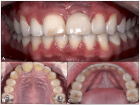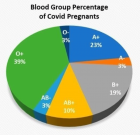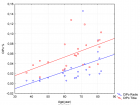Abstract
Research Article
Percentage of Positive Biopsy Cores Predicts Presence of a Dominant Lesion on MRI in Patients with Intermediate Risk Prostate Cancer
Jason M Slater, William W Millard, Samuel M Randolph, Thomas J Kelly and David A Bush*
Published: 12 October, 2018 | Volume 2 - Issue 3 | Pages: 073-079
Background: Biopsy findings of percentage of positive biopsy cores, percentage of cancer volume, and maximum involvement of biopsy cores have been shown to have prognostic value and correlate with magnetic resonance imaging (MRI) findings of extracapsular extension and seminal vesicle invasion. The relationship of these prognostic biopsy factors to MRI findings of the presence of a dominant lesion, has not yet been investigated.
Methods: Sixty-five patients with intermediate risk prostate cancer were included in a retrospective cohort. MRI was acquired using either 1.5 Tesla (T) with endorectal coil or a 3 T MRI unit. Findings of extracapsular extension, seminal vesicle invasion, and presence and number of dominant lesions were noted. T-test and Cox regression statistical analyses were performed.
Results: Patients with one or more dominant lesions on MRI had a significantly higher mean percentage of positive biopsy cores (56.7% vs 39.8%, p=0.004), percentage of cancer volume (23.5% vs 14.5%, p=0.011) and maximum involvement of biopsy cores (62.9% vs 47.3%, p=0.027) than those without a dominant lesion on MRI. On multivariate analysis, only percentage of positive biopsy cores remained a statistically significant predictor for a dominant lesion on MRI (Hazard Ratio 1.06 [95% CI 1.01-1.12; p=0.02]), whereas prostate-specific antigen, clinical T-stage, Gleason score, percentage of cancer volume, and maximum involvement of biopsy cores were not significant predictors of a dominant lesion on MRI. Receiver-operator characteristic analysis was done and a cutoff value of >=50% was chosen for percentage of positive biopsy cores, >=15% for percentage of cancer volume, >=50% for maximum involvement of biopsy cores.
Conclusion: Percentage of positive biopsy cores was found to be a significant predictor for the presence of a dominant lesion on MRI. This finding is hypothesis-generating and should be confirmed with a prospective trial.
Read Full Article HTML DOI: 10.29328/journal.jro.1001025 Cite this Article Read Full Article PDF
Keywords:
Prostate cancer; Biopsy cores; MRI; Prognosis; Multivariate analysis
References
- D'Amico AV, Whittington R, Malkowicz SB, Schultz D, Blank K, et al. Biochemical outcome after radical prostatectomy, external beam radiation therapy, or interstitial radiation therapy for clinically localized prostate cancer. JAMA. 1998; 280: 969-974. Ref.: https://goo.gl/1yqNnc
- Vance SM, Stenmark MH, Blas K, Halverson S, Hamstra DA, et al. Percentage of cancer volume in biopsy cores is prognostic for prostate cancer death and overall survival in patients treated with dose-escalated external beam radiotherapy. Int J Radiat Oncol Biol Phys. 2012; 83: 940-946. Ref.: https://goo.gl/M2foMH
- Slater JM, Bush DA, Grove R, Slater JD. The prognostic value of percentage of positive biopsy cores, percentage of cancer volume, and maximum involvement of biopsy cores in prostate cancer patients receiving proton and photon beam therapy. Technol Cancer Res Treat. 2014; 13: 227-231. Ref.: https://goo.gl/A1EFXG
- Murgic J, Stenmark MH, Halverson S, Blas K, Feng FY, et al. The role of the maximum involvement of biopsy core in predicting outcome for patients treated with dose-escalated radiation therapy for prostate cancer. Radiat Oncol. 2012; 7: 127. Ref.: https://goo.gl/q9RhKq
- Nelson CP, Rubin MA, Strawderman M, Montie JE, Sanda MG. Preoperative parameters for predicting early prostate cancer recurrence after radical prostatectomy. Urology. 2002; 59: 740-745. Ref.: https://goo.gl/yrtDCL
- Feng TS, Sharif-Afshar AR, Wu J, Li Q, Luthringer D, et al. Multiparametric MRI improves accuracy of clinical nomograms for predicting extracapsular extension of prostate cancer. Urology. 2015; 86: 332-337. Ref.: https://goo.gl/o54Y1i
- Fuchsjager MH, Pucar D, Zelefsky MJ, Zhang Z, Mo Q, et al. Predicting post-external beam radiation therapy PSA relapse of prostate cancer using pretreatment MRI. Int J Radiat Oncol Biol Phys. 2010; 78: 743-750. Ref.: https://goo.gl/iY3yzh
- Nguyen PL, Whittington R, Koo S, Schultz D, Cote KB, et al. Quantifying the impact of seminal vesicle invasion identified using endorectal magnetic resonance imaging on PSA outcome after radiation therapy for patients with clinically localized prostate cancer. Int J Radiat Oncol Biol Phys. 2004; 59: 400-405. Ref.: https://goo.gl/nMXL1v
- Zakian KL, Hricak H, Ishill N, Reuter VE, Eberhardt S, et al. An exploratory study of endorectal magnetic resonance imaging and spectroscopy of the prostate as preoperative predictive biomarkers of biochemical relapse after radical prostatectomy. J Urol. 2010; 184: 2320-2327. Ref.: https://goo.gl/hXborX
- Clarke DH, Banks SJ, Wiederhorn AR, Klousia JW, Lissy JM, et al. The role of endorectal coil MRI in patient selection and treatment planning for prostate seed implants. Int J Radiat Oncol Biol Phys. 2002; 52: 903-910. Ref.: https://goo.gl/AgXF9h
- Pugh TJ, Frank SJ, Achim M, Kuban DA, Lee AK, et al. Endorectal magnetic resonance imaging for predicting pathologic T3 disease in Gleason score 7 prostate cancer: implications for prostate brachytherapy. Brachytherapy. 2013; 12: 204-209. Ref.: https://goo.gl/LmruXi
- Gondo T, Hricak H, Sala E, Zheng J, Moskowitz CS, et al. Multiparametric 3T MRI for the prediction of pathological downgrading after radical prostatectomy in patients with biopsy-proven Gleason score 3 + 4 prostate cancer. Eur Radiol. 2014; 24: 3161-3170. Ref.: https://goo.gl/SdCDT9
- Wang L, Hricak H, Kattan MW, Chen HN, Kuroiwa K, et al. Prediction of seminal vesicle invasion in prostate cancer: incremental value of adding endorectal MR imaging to the Kattan nomogram. Radiology. 2007; 242: 182-188. Ref.: https://goo.gl/3k8DKb
- Qian Y, Feng FY, Halverson S, Blas K, Sandler HM, et al. The percent of positive biopsy cores improves prediction of prostate cancer-specific death in patients treated with dose-escalated radiotherapy. Int J Radiat Oncol Biol Phys. 2011; 81: e135-142. Ref.: https://goo.gl/t5wviF
- Chang ST, Westphalen AC, Jha P, Jung AJ, Carroll PR, et al. Endorectal MRI and MR spectroscopic imaging of prostate cancer: developing selection criteria for MR-guided focal therapy. J Magnetic Res Imag: JMRI. 2014; 39: 519-525. Ref.: https://goo.gl/coQzPL
- Rischke HC, Nestle U, Fechter T, Doll C, Volegova-Neher N, et al. 3 Tesla multiparametric MRI for GTV-definition of dominant intraprostatic lesions in patients with prostate cancer--an interobserver variability study. Radiat Oncol. 2013; 8: 183. Ref.: https://goo.gl/ME3bpg
- von Eyben FE, Kiljunen T, Kangasmaki A, Kairemo K, von Eyben R, et al. Radiotherapy boost for the dominant intraprostatic cancer lesion - a systematic review and meta-analysis. Clin Genitourin Cancer. 2016; 14: 189-197. Ref.: https://goo.gl/Jwv4sV
- Zumsteg ZS, Spratt DE, Pei I, Zhang Z, Yamada Y, et al. A new risk classification system for therapeutic decision making with intermediate-risk prostate cancer patients undergoing dose-escalated external-beam radiation therapy. European urology. 2013; 64: 895-902. Ref.: https://goo.gl/KCmuZi
- Mouraviev V, Villers A, Bostwick DG, Wheeler TM, Montironi R, et al. Understanding the pathological features of focality, grade and tumour volume of early-stage prostate cancer as a foundation for parenchyma-sparing prostate cancer therapies: active surveillance and focal targeted therapy. BJU Int. 2011; 108: 1074-1085. Ref.: https://goo.gl/kqUfs6
- Gomez-Iturriaga A, Casquero F, Urresola A, Ezquerro A, Lopez JI, et al. Dose escalation to dominant intraprostatic lesions with MRI-transrectal ultrasound fusion high-dose-rate prostate brachytherapy. Prospective phase II trial. Radiother and Oncol. 2016; 119: 91-96. Ref.: https://goo.gl/6JP1JP
- Vigneault E, Mbodji K, Racine LG, Chevrette E, Lavallee MC, et al. Image-Guided high-dose-rate (HDR) boost localization using MRI/MR spectroscopy: a correlation study with biopsy. Cureus. 2016; 8: e795. Ref.: https://goo.gl/Tvjdvi
- Gomez-Iturriaga A, Casquero F, Lopez JI, Urresola A, Ezquerro A, et al. Transperineal biopsies of MRI-detected aggressive index lesions in low- and intermediate-risk prostate cancer patients: Implications for treatment decision. Brachytherapy. 2016; 16: 201–206. Ref.: https://goo.gl/QvGkVn
Similar Articles
-
Near Complete Response to 177Lu-PSMA-DKFZ-617 Therapy in a Patient with Metastatic Castration Resistant Prostate CancerMadhav Prasad Yadav,Sanjana Ballal a,Chandrasekhar Bal*. Near Complete Response to 177Lu-PSMA-DKFZ-617 Therapy in a Patient with Metastatic Castration Resistant Prostate Cancer. . 2017 doi: 10.29328/journal.jro.1001012; 1: 083-086
-
Diagnostic accuracy of Magnetic Resonance Imaging to differentiate benign and Malignant Parotid Gland TumorsSadia Ali,Adeena Khan*,Kiran Sarfaraz,Saba Akram,Mariam Javaid,Asma Bano. Diagnostic accuracy of Magnetic Resonance Imaging to differentiate benign and Malignant Parotid Gland Tumors. . 2018 doi: 10.29328/journal.jro.1001026; 2: 080-086
-
Percentage of Positive Biopsy Cores Predicts Presence of a Dominant Lesion on MRI in Patients with Intermediate Risk Prostate CancerJason M Slater,William W Millard,Samuel M Randolph,Thomas J Kelly,David A Bush*. Percentage of Positive Biopsy Cores Predicts Presence of a Dominant Lesion on MRI in Patients with Intermediate Risk Prostate Cancer. . 2018 doi: 10.29328/journal.jro.1001025; 2: 073-079
-
Clinically and Radiological isolated syndrome (MS risk)Hassan Ahmed Hashem*,Yasser Hamed Mustafa,Abdelazim M Reda,Sameh Azab,Ahmed M Solaiman. Clinically and Radiological isolated syndrome (MS risk). . 2018 doi: 10.29328/journal.jro.1001020; 2: 041-046
-
Ra-223 dichloride management in a Nuclear Medicine Unit: experience of a referral institutionGiulia Anna Follacchio*,Viviana Frantellizzi,Francesco Monteleone,Giuseppe De Vincentis,Mauro Liberatore. Ra-223 dichloride management in a Nuclear Medicine Unit: experience of a referral institution. . 2017 doi: 10.29328/journal.jro.1001010; 1: 069-078
-
The value of bone scans to predict survival time in patients with diagnosed prostate cancer: single-center retrospective studyElif Marangoz,Doğangün Yüksel*,Olga Yaylalı,Saadettin Yılmaz Eskiçorapçı,Nilay Şen,Hülya Aybek,Fatma Suna Kıraç. The value of bone scans to predict survival time in patients with diagnosed prostate cancer: single-center retrospective study. . 2022 doi: 10.29328/journal.jro.1001040; 6: 004-011
-
The effects of boric acid and disodium pentaborate dechydrate in metastatic prostate cancer cellsMerve Tütüncü*,Selen Kum Özşengezer,Tuğba Karakayali,Zekiye S Altun. The effects of boric acid and disodium pentaborate dechydrate in metastatic prostate cancer cells. . 2022 doi: ; 6: 012-017
-
The effects of boric acid and disodium pentaborate dechydrate in metastatic prostate cancer cellsMerve Tütüncü*,Selen Kum Özşengezer,Tuğba Karakayali,Zekiye S Altun. The effects of boric acid and disodium pentaborate dechydrate in metastatic prostate cancer cells. . 2022 doi: 10.29328/journal.jro.1001041; 6: 012-017
-
Environmental Modeling for Radiation SafetyPaweł Krajewsk*, Grażyna Krajewska. Environmental Modeling for Radiation Safety. . 2023 doi: 10.29328/journal.jro.1001053; 7: 052-055
-
Multiparametric MRI for the Assessment of Treatment Effect and Tumor Recurrence in Soft-tissue Sarcoma of the ExtremitiesRaul F Valenzuela*, Behrang Amini, Elvis Duran-Sierra, MA Canjirathinkal, John E Madewell, Colleen M Costelloe, William A Murphy. Multiparametric MRI for the Assessment of Treatment Effect and Tumor Recurrence in Soft-tissue Sarcoma of the Extremities. . 2023 doi: 10.29328/journal.jro.1001055; 7: 058-065
Recently Viewed
-
Advancing Forensic Approaches to Human Trafficking: The Role of Dental IdentificationAiswarya GR*. Advancing Forensic Approaches to Human Trafficking: The Role of Dental Identification. J Forensic Sci Res. 2025: doi: 10.29328/journal.jfsr.1001076; 9: 025-028
-
Scientific Analysis of Eucharistic Miracles: Importance of a Standardization in EvaluationKelly Kearse*,Frank Ligaj. Scientific Analysis of Eucharistic Miracles: Importance of a Standardization in Evaluation. J Forensic Sci Res. 2024: doi: 10.29328/journal.jfsr.1001068; 8: 078-088
-
Sinonasal Myxoma Extending into the Orbit in a 4-Year Old: A Case PresentationJulian A Purrinos*, Ramzi Younis. Sinonasal Myxoma Extending into the Orbit in a 4-Year Old: A Case Presentation. Arch Case Rep. 2024: doi: 10.29328/journal.acr.1001099; 8: 075-077
-
Toxicity and Phytochemical Analysis of Five Medicinal PlantsJohnson-Ajinwo Okiemute Rosa*, Nyodee, Dummene Godwin. Toxicity and Phytochemical Analysis of Five Medicinal Plants. Arch Pharm Pharma Sci. 2024: doi: 10.29328/journal.apps.1001054; 8: 029-040
-
Antibacterial Screening of Lippia origanoides Essential Oil on Gram-negative BacteriaRodrigo Marcelino Zacarias de Andrade, Bernardina de Paixão Santos, Roberson Matteus Fernandes Silva, Mateus Gonçalves Silva*, Igor de Sousa Oliveira, Sávio Benvindo Ferreira, Rafaelle Cavalcante Lira. Antibacterial Screening of Lippia origanoides Essential Oil on Gram-negative Bacteria. Arch Pharm Pharma Sci. 2024: doi: 10.29328/journal.apps.1001053; 8: 024-028.
Most Viewed
-
Evaluation of Biostimulants Based on Recovered Protein Hydrolysates from Animal By-products as Plant Growth EnhancersH Pérez-Aguilar*, M Lacruz-Asaro, F Arán-Ais. Evaluation of Biostimulants Based on Recovered Protein Hydrolysates from Animal By-products as Plant Growth Enhancers. J Plant Sci Phytopathol. 2023 doi: 10.29328/journal.jpsp.1001104; 7: 042-047
-
Sinonasal Myxoma Extending into the Orbit in a 4-Year Old: A Case PresentationJulian A Purrinos*, Ramzi Younis. Sinonasal Myxoma Extending into the Orbit in a 4-Year Old: A Case Presentation. Arch Case Rep. 2024 doi: 10.29328/journal.acr.1001099; 8: 075-077
-
Feasibility study of magnetic sensing for detecting single-neuron action potentialsDenis Tonini,Kai Wu,Renata Saha,Jian-Ping Wang*. Feasibility study of magnetic sensing for detecting single-neuron action potentials. Ann Biomed Sci Eng. 2022 doi: 10.29328/journal.abse.1001018; 6: 019-029
-
Pediatric Dysgerminoma: Unveiling a Rare Ovarian TumorFaten Limaiem*, Khalil Saffar, Ahmed Halouani. Pediatric Dysgerminoma: Unveiling a Rare Ovarian Tumor. Arch Case Rep. 2024 doi: 10.29328/journal.acr.1001087; 8: 010-013
-
Physical activity can change the physiological and psychological circumstances during COVID-19 pandemic: A narrative reviewKhashayar Maroufi*. Physical activity can change the physiological and psychological circumstances during COVID-19 pandemic: A narrative review. J Sports Med Ther. 2021 doi: 10.29328/journal.jsmt.1001051; 6: 001-007

HSPI: We're glad you're here. Please click "create a new Query" if you are a new visitor to our website and need further information from us.
If you are already a member of our network and need to keep track of any developments regarding a question you have already submitted, click "take me to my Query."


















































































































































